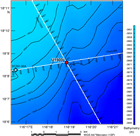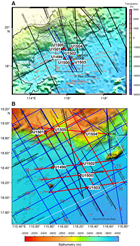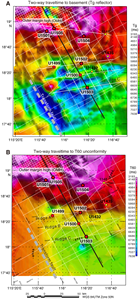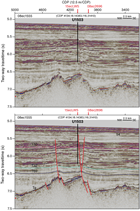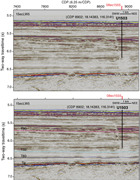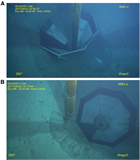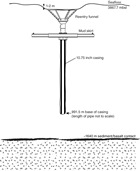Sun, Z., Jian, Z., Stock, J.M., Larsen, H.C., Klaus, A., Alvarez Zarikian, C.A., and the Expedition 367/368 Scientists
Proceedings of the International Ocean Discovery Program Volume 367/368
publications.iodp.org
https://doi.org/10.14379/iodp.proc.367368.107.2018
Site U15031
Hans Christian Larsen, Zhimin Jian, Carlos A. Alvarez Zarikian, Zhen Sun, Joann M. Stock, Adam Klaus, Jacopo Boaga, Stephen A. Bowden, Anne Briais, Yifeng Chen, Deniz Cukur, Kelsie A. Dadd, Weiwei Ding, Michael J. Dorais, Eric C. Ferré, Fabricio Ferreira, Akira Furusawa, Aaron J. Gewecke, Jessica L. Hinojosa, Tobias W. Höfig, Kan-Hsi Hsiung, Baoqi Huang, Enqing Huang, Xiao-Long Huang, Shijun Jiang, Haiyan Jin, Benjamin G. Johnson, Robert M. Kurzawski, Chao Lei, Baohua Li, Li Li, Yanping Li, Jian Lin, Chang Liu, Chuanlian Liu, Zhifei Liu, Antonio Luna, Claudia Lupi, Anders J. McCarthy, Geoffroy Mohn, Lachit Singh Ningthoujam, Michael Nirrengarten, Nobuaki Osono, David W. Peate, Patricia Persaud, Ning Qiu, Caroline M. Robinson, Sara Satolli, Isabel Sauermilch, Julie C. Schindlbeck, Steven M. Skinner, Susanne M. Straub, Xiang Su, Liyan Tian, Froukje M. van der Zwan, Shiming Wan, Huaichun Wu, Rong Xiang, Rajeev Yadav, Liang Yi, Cuimei Zhang, Jinchang Zhang, Yang Zhang, Ning Zhao, Guangfa Zhong, and Lifeng Zhong2
Keywords: International Ocean Discovery Program, IODP, JOIDES Resolution, Expedition 367, Expedition 368, Site U1503, northern South China Sea, continent–ocean transition zone, Ridge C, hyperextension, continental breakup, thinning, rifting, Cenozoic
Site summary
Background and objectives
International Ocean Discovery Program (IODP) Site U1503 (proposed Site SCSII-9B; Sun at al., 2016) is located at 3868 meters below sea level (mbsl) near the top of the structural high named Ridge C (Figures F1, F2). Ridge C is the most seaward ridge of the three margin-parallel Ridges A, B, and C that characterize the lower continental slope underlain by thin (5–7 km) crust. Ridge C is believed to represent at least partly, if not fully, igneous crust and hence the completion of continental breakup along this margin segment of the northern South China Sea (SCS).
A key operational objective of Site U1503 was to sample the lowermost ~300 m of sediments on top of basement to constrain the age and subsidence history of the crust at this location, the timing of normal faulting, and the environment of the early half-graben fill. The most important goal was to sample the igneous stratigraphy to at least 100 m below the basement. Because of a rig floor equipment failure (drawworks), we abandoned the site after installing casing in Hole U1503A to 991.5 m.
Deep, representative sampling of the basaltic material at this site would have provided an important reference frame for breakup modeling. With an estimated 1640 m sediment thickness overlying basement, obtaining basement samples and log data at this site represented a challenging operation.
Operations
To reach our objectives, we conducted operations in one hole (U1503A; 18°08.6300′N, 116°18.8456′E; 3868 mbsl). We successfully installed a reentry system and 991.5 m of 10¾ inch casing in Hole U1503A. However, we were unable to deepen the hole below the casing because of repeated breakdowns of the low clutch diaphragm in the drawworks and concerns that we did not have enough spares to last the remainder of the expedition. Without the drawworks’ low clutch, we could not conduct drilling operations deeper than 3400 m (water depth plus penetration depth). Because Site U1503 had a planned depth of 5695 m (water depth plus penetration depth), we abandoned Hole U1503A without addressing any scientific objectives. Hole U1503A remains cased and open for possible future occupation.
Background and objectives
Site U1503 is located at 3867.7 mbsl (Figures F1, F2) near the top of the structural high named Ridge C. Ridge C is the most seaward ridge of the three margin-parallel Ridges A, B, and C that characterize the lower continental slope underlain by thin (5–7 km) crust (Figures F3, F4). Ridge C is believed to represent at least partly, if not fully, igneous crust and hence the completion of continental breakup along this margin segment of the northern SCS.
Ridge C is a remarkably continuous basement ridge consisting of two ridges separated by seaward-dipping normal faults (Figures F4, F5, F6). The offset of the normal faults is as high as ~400 ms two-way traveltime (TWT; ~400 m), and faulting apparently was active shortly after the formation of the igneous crust. Only the oldest of the overlying sediments filling the half-graben basins seems to be offset by the faults, whereas the younger sediments filling in the majority of the accommodation space generated by normal faulting shows a draping (and compaction) structure over the tectonically generated basement relief. Ridge C is very linear and parallel to Ridge B (see the Site U1500 chapter [Stock et al., 2018]) and seafloor spreading anomalies south of the ridge (Figure F2). The top of the ridge is also remarkably flat along strike.
One important objective of Site U1503 was to sample the lowermost ~300 m of sediments on top of the basement to constrain the age and subsidence history of the crust in this location, the timing of normal faulting, and the environment of the early half-graben fill. The most important goal was to sample the igneous stratigraphy to at least 100 m below top of basement.
Based on the breakup-related basaltic magmatism found at both Sites U1502 (Ridge A) and U1500 (Ridge B), we believe that this rifted margin, unlike magma-starved Iberia-type margins, experienced massive igneous activity during breakup and that highly extended subcontinental lithosphere within the continent–ocean transition (COT), if present at all, now is likely to be more or less covered by igneous rocks. By implication, the reading of the terminal stages of lithospheric thinning prior to final breakup needs to be gleaned from the detailed composition of the igneous products, such as continental crustal contamination of the magmas, depth of and shallowing of mantle melting with time, and mantle composition, including wetness and possible temperature anomalies. The crust at Ridge C is interpreted to represent the end-member of the transition from breakup igneous activity initially modified by an overlying lid of continental lithosphere to accretion of igneous crust unmodified by a preexisting lithosphere. Deep representative sampling of the basaltic material at this site therefore forms an important reference frame for the modeling of breakup, and basement penetration must be sufficient to provide a representative sampling of igneous units. With an estimated 1640 m of sediment to basement, Site U1503 was a challenging operation. Unfortunately, following installation of 990 m of steel casing within the upper sediments, repeated breakdown of the drawworks’ low clutch diaphragm (see Operations) prevented Expedition 368 from deploying a drill string longer than 3400 m (water depth plus penetration), and Site U1503 was left for possible occupation during a future expedition.
The 3400 m depth limit imposed by the flawed drawworks left very few drilling options for continuation of Expedition 368 operations. Almost all proposed sites are in water depths greater than 3400 m and/or had deep targets. One exception was Site U1504, which is located in 2823 mbsl and has a shallow coring target (see Background and objectives in the Site U1504 chapter [Larsen et al., 2018]).
Operations
We conducted operations in one hole at Site U1503 (Table T1) with the objective of sampling the lowermost sediments and 150 m into the underlying basalt. Hole U1503A is located at 18°08.6300′N, 116°18.8456′E, at a water depth of 3867.7 m. We installed a reentry system and 991.5 m of casing (10¾ inch) in this hole. However, we were unable to continue deepening the hole because of mechanical problems with the drawworks, including a fourth clutch diaphragm failure and a breakdown of the aft shaft bearing on one of the Elmagco brakes. The continuing failures of the low clutch diaphragm and the lack of available spares to last until the end of the expedition limited the operation of the ship’s drilling equipment to depths shallower than 3400 m. Therefore, Site U1503 was abandoned without achieving any scientific objectives. Despite this major setback to the expedition and the South China Sea Rifted Margin program, Hole U1503A remains as a legacy hole for future occupation.
Table T1. Site U1503 core summary. View table in PDF format. Download table in CSV format.
Hole U1503A
The R/V JOIDES Resolution began the transit from Site U1502 to Site U1503 in dynamic positioning mode while tripping pipe. The mud skirt and reentry cone intended for Site U1503 were moved to the center of the moonpool and stationed on the moonpool doors. With the mud skirt and reentry cone secured, the thrusters were pulled, and the vessel was underway at full speed at 0806 h on 14 May 2017.
The vessel arrived on site at 0930 h on 14 May but was unable to occupy the site until 1130 h because the Chinese R/V Shiyan 2, operated by the South China Sea Institute of Oceanology, was conducting a seismic survey in the area. The JOIDES Resolution completed the 19.8 nmi voyage from Site U1502 in 8.6 h (7.2 h in dynamic positioning mode and 1.4 h at cruise speed).
Once on site, a seafloor positioning beacon was deployed and the crew made up the bottom-hole assembly (BHA) with a 14¾ inch bit to drill a hole without coring to 1000 m for installation of 10¾ inch casing. The bit was lowered through the reentry cone and base that was assembled and placed in the moonpool. The precision depth recorder (PDR) measurement taken upon arrival placed the seafloor at 3873.1 mbsl. The bit was lowered to 3846 mbsl, the top drive was picked up, and drilling in Hole U1503A started at 2010 h on 14 May. Drilling of the 14¾ inch diameter hole penetrated to a total depth of 902.8 m at 0100 h on 16 May. At this time, the rig mechanic noticed a leak in the low clutch diaphragm, which had already been replaced once during Expedition 367 and twice during Expedition 368. It was decided to pull the bit to the surface before the diaphragm failed completely. The bit was raised to 97.6 m below the seafloor, and a reentry cone was deployed. The subsea camera was lowered to observe the landing orientation of the cone (Figure F7A). Once the camera was near the seafloor, the bit was pulled out of the hole, clearing the seafloor at 0750 h on 16 May. The bit tagged the internal aperture of the cone to verify a seafloor depth of 3867.7 m, 5.4 m higher than previously thought. The seafloor depth for this hole was adjusted to 908.2 m.
The bit was then pulled to 3846 m, and 215 ft of drill line was slipped and cut. The bit was pulled to the surface, clearing the rotary table at 1655 h. With no spare clutch diaphragms aboard and no possible delivery of spare diaphragms until ~20 May, it was decided to proceed with all operations that would not require use of the low drive of the drawworks.
The drill crew assembled 85 joints (989.3 m) of 10¾ inch casing and crossed over to a 16 inch casing hanger. During an attempt to engage the DrilQuip running tools, it was noted that the seal diameter on the casing hanger was too small. The crew modified the hanger to enlarge the seal diameter and engaged the running tool. The casing was then lowered into the moonpool and hung off the moonpool doors.
The crew then picked up the mud motor and underreamer, lowered the drilling assembly into the moonpool, and tested them. The rest of the drilling assembly was made up and lowered through the casing. The running tool was then reengaged into the casing hanger, and the entire casing string and drilling assembly were lowered as far as possible (2379 m) without using the drawworks low clutch and then hung off the traveling blocks. The last operation was to make up three stands of knobbies and pump a pig through each stand to clean any rust. The stands were then racked back in the derrick for use when drilling in the casing.
The rig then went on downtime on Thursday, 18 May, at 0915 h until the replacement parts (low clutch diaphragms) were delivered to the ship at 2310 h on 20 May. The seagoing tug Taikoo arrived on site with three spare low clutch diaphragms. The tug stationed itself on the port aft side of the JOIDES Resolution. Supplies were offloaded, the tug departed by 2320 h on 20 May, and the crew began replacing the low clutch diaphragm.
Repairs were completed by 0415 h on 21 May. The driller continued lowering the casing string from 2379 mbsl to the seafloor, filling the pipe with seawater every 25 stands. The subsea camera was deployed, and Hole U1503A was reentered at 1005 h on 21 May with the 10¾ inch casing string. The casing began taking weight at 342 m, so it was pulled back, the top drive was installed, and the mud motor, bit, and underreamer were used to drill in the casing to the bottom of the predrilled hole at 908.2 m. We continued drilling in the last 86.9 m of casing until we reached 991.5 m. The casing was released at 0915 h on 22 May, and the camera and drilling assembly were recovered. The mud motor and underreamer were flushed with freshwater and laid out. The casing running tool was detorqued and laid out.
The upper guide horn (UGH) was installed, and the drill crew began making up and deploying a rotary core barrel (RCB) BHA. The bit was lowered to 1232 mbsl, at which depth the drill crew noticed a loud noise coming from the forward Elmagco brake of the drawworks. The aft bearing on the forward Elmagco brake had failed. The crew began working to replace the brake with a reconditioned unit that was loaded aboard in Hong Kong. This job was scheduled for the maintenance period following Expedition 368. We were lucky that the seas were calm because this typically can’t be done at sea.
Repairs began at ~0530 h on 23 May. Because of the calm seas, the crew was able to make the required heavy crane lifts. The forward brake was disconnected and moved to the rig floor where the hub could be removed for use on the replacement. The 28,000 lb (12.7 MT) nonfunctioning brake was then transferred to the main deck, and the replacement brake was moved to the rig floor to have the hub fitted and to be installed on the forward end of the drawworks. The brake was moved into place, the electrical and water connections were made, and the shaft was aligned by 0600 h on 25 May.
Operations resumed with lowering the bit to 3819 mbsl at 1100 h on 25 May, at which time it was noticed that the low clutch diaphragm was leaking again. The diaphragm was replaced for the fourth time during this expedition (completed at 2100 h on 25 May). Because of the great water depth at the site’s location combined with the planned deep penetration at Site U1503, extensive use of the low clutch would have been required to continue operations. Considering this fact, along with the number of diaphragm failures so far and a single remaining spare left on board the ship, it was determined that the safest action would be to terminate operations in Hole U1503A without reentering the cased hole. An optimistic delivery date for additional clutch diaphragm spares, if available, was estimated for 2 June. If Hole U1503A was reentered and an additional clutch diaphragm failed while coring below the casing, the remaining spare would be enough only to get the drill string out of the hole, and any failed operations in the open hole could have prevented a future reentry operation. With two more weeks left of the expedition, the very difficult decision was made to switch to operations at sites with shallower water depths and penetration that did not require the use of the low clutch while drilling or coring. Therefore, we decided to transit to Site U1504 (2816 mbsl) and continue operations there.
Before departing from Site U1503, the subsea camera was deployed to the seafloor to inspect the Hole U1503A reentry. The cone appeared to be 1–2 m below the seafloor but was clearly visible and expected to be available for reentry at a later date (Figures F7B, F8). Consequently, the site can be considered a legacy site for future expeditions. The camera was retrieved, the bit was recovered, and the rig was secured for transit. The thrusters were up at 0930 h on 26 May, and the vessel began the 42.5 nmi transit to Site U1504.
References
Briais, A., Patriat, P., and Tapponnier, P., 1993. Updated interpretation of magnetic anomalies and seafloor spreading stages in the South China Sea: implications for the Tertiary tectonics of Southeast Asia. Journal of Geophysical Research: Solid Earth, 98(B4):6299–6328. https://doi.org/10.1029/92JB02280
Larsen, H.C., Jian, Z., Alvarez Zarikian, C.A., Sun, Z., Stock, J.M., Klaus, A., Boaga, J., Bowden, S.A., Briais, A., Chen, Y., Cukur, D., Dadd, K.A., Ding, W., Dorais, M.J., Ferré, E.C., Ferreira, F., Furusawa, A., Gewecke, A.J., Hinojosa, J.L., Höfig, T.W., Hsiung, K.-H., Huang, B., Huang, E., Huang, X.-L., Jiang, S., Jin, H., Johnson, B.G., Kurzawski, R.M., Lei, C., Li, B., Li, L., Li, Y., Lin, J., Liu, C., Liu, C., Liu, Z., Luna, A., Lupi, C., McCarthy, A.J., Mohn, G., Ningthoujam, L.S., Nirrengarten, M., Osono, N., Peate, D.W., Persaud, P., Qui, N., Robinson, C.M., Satolli, S., Sauermilch, I., Schindlbeck, J.C., Skinner, S.M., Straub, S.M., Su, X., Tian, L., van der Zwan, F.M., Wan, S., Wu, H., Xiang, R., Yadav, R., Yi, L., Zhang, C., Zhang, J., Zhang, Y., Zhao, N., Zhong, G., and Zhong, L., 2018. Site U1504. In Sun, Z., Jian, Z., Stock, J.M., Larsen, H.C., Klaus, A., Alvarez Zarikian, C.A., and the Expedition 367/368 Scientists, South China Sea Rifted Margin. Proceedings of the International Ocean Discovery Program, 367/368: College Station, TX (International Ocean Discovery Program). https://doi.org/10.14379/iodp.proc.367368.108.2018
Stock, J.M., Sun, Z., Klaus, A., Larsen, H.C., Jian, Z., Alvarez Zarikian, C.A., Boaga, J., Bowden, S.A., Briais, A., Chen, Y., Cukur, D., Dadd, K.A., Ding, W., Dorais, M.J., Ferré, E.C., Ferreira, F., Furusawa, A., Gewecke, A.J., Hinojosa, J.L., Höfig, T.W., Hsiung, K.-H., Huang, B., Huang, E., Huang, X.-L., Jiang, S., Jin, H., Johnson, B.G., Kurzawski, R.M., Lei, C., Li, B., Li, L., Li, Y., Lin, J., Liu, C., Liu, C., Liu, Z., Luna, A., Lupi, C., McCarthy, A.J., Mohn, G., Ningthoujam, L.S., Nirrengarten, M., Osono, N., Peate, D.W., Persaud, P., Qui, N., Robinson, C.M., Satolli, S., Sauermilch, I., Schindlbeck, J.C., Skinner, S.M., Straub, S.M., Su, X., Tian, L., van der Zwan, F.M., Wan, S., Wu, H., Xiang, R., Yadav, R., Yi, L., Zhang, C., Zhang, J., Zhang, Y., Zhao, N., Zhong, G., and Zhong, L., 2018. Site U1500. In Sun, Z., Jian, Z., Stock, J.M., Larsen, H.C., Klaus, A., Alvarez Zarikian, C.A., and the Expedition 367/368 Scientists, South China Sea Rifted Margin. Proceedings of the International Ocean Discovery Program, 367/368: College Station, TX (International Ocean Discovery Program). https://doi.org/10.14379/iodp.proc.367368.104.2018
Sun, Z., Stock, J., Jian, Z., McIntosh, K., Alvarez Zarikian, C.A., and Klaus, A., 2016. Expedition 367/368 Scientific Prospectus: South China Sea Rifted Margin. International Ocean Discovery Program. https://doi.org/10.14379/iodp.sp.367368.2016
Yan, P., Zhou, D., and Liu, Z., 2001. A crustal structure profile across the northern continental margin of the South China Sea. Tectonophysics, 338(1):1–21. https://doi.org/10.1016/S0040-1951(01)00062-2
1 Larsen, H.C., Jian, Z., Alvarez Zarikian, C.A., Sun, Z., Stock, J.M., Klaus, A., Boaga, J., Bowden, S.A., Briais, A., Chen, Y., Cukur, D., Dadd, K.A., Ding, W., Dorais, M.J., Ferré, E.C., Ferreira, F., Furusawa, A., Gewecke, A.J., Hinojosa, J.L., Höfig, T.W., Hsiung, K.-H., Huang, B., Huang, E., Huang, X.-L., Jiang, S., Jin, H., Johnson, B.G., Kurzawski, R.M., Lei, C., Li, B., Li, L., Li, Y., Lin, J., Liu, C., Liu, C., Liu, Z., Luna, A., Lupi, C., McCarthy, A.J., Mohn, G., Ningthoujam, L.S., Nirrengarten, M., Osono, N., Peate, D.W., Persaud, P., Qui, N., Robinson, C.M., Satolli, S., Sauermilch, I., Schindlbeck, J.C., Skinner, S.M., Straub, S.M., Su, X., Tian, L., van der Zwan, F.M., Wan, S., Wu, H., Xiang, R., Yadav, R., Yi, L., Zhang, C., Zhang, J., Zhang, Y., Zhao, N., Zhong, G., and Zhong, L., 2018. Site U1503. In Sun, Z., Jian, Z., Stock, J.M., Larsen, H.C., Klaus, A., Alvarez Zarikian, C.A., and the Expedition 367/368 Scientists, South China Sea Rifted Margin. Proceedings of the International Ocean Discovery Program, 367/368: College Station, TX (International Ocean Discovery Program). https://doi.org/10.14379/iodp.proc.367368.107.2018
2 Expedition 367/368 Scientists’ addresses.
MS 367368-107: Published 28 September 2018
This work is distributed under the Creative Commons Attribution 4.0 International (CC BY 4.0) license. 
- F1. Bathymetry and seismic lines.
- F2. Northern SCS margin with seismic and ocean-bottom seismometer data.
- F3. Two-way traveltime to Tg and T60 unconformities.
- F4. Deep crustal time-migrated seismic reflection data.
- F5. Seismic Line 08ec1555.
- F6. Crossing seismic Line 15ecLW5.
- F7. Reentry system on seafloor after free fall.
- F8. Reentry system and casing.
